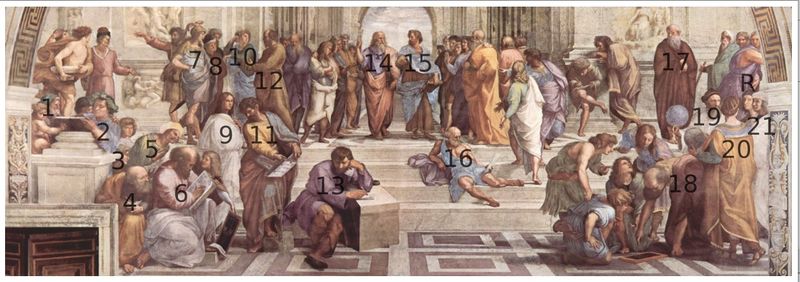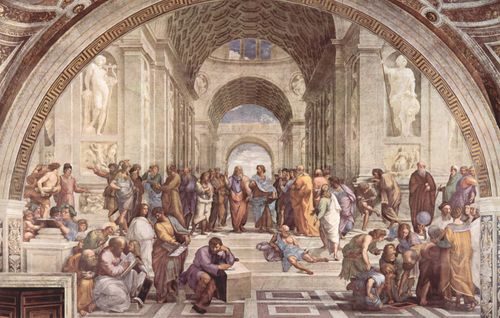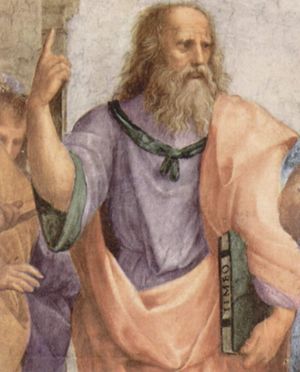The School of Athens
The School of Athens, or Scuola di Atene in Italian, is one of the most famous paintings by the Italian Renaissance artist Raphael.
Contents
The painting
The School of Athens was painted between 1510 and 1511 as a part of Raphael's commission to decorate with frescoes the rooms now known as the Stanze di Raffaello, in the Apostolic Palace in the Vatican. [1]
The topic
The "School of Athens" is one of a group of four main frescoes on the walls of the Stanza (those on either side centrally interrupted by windows) that depict distinct branches of knowledge.

1: Zeno of Citium 2: Epicurus 3: Federico II of Mantua|Federico II, Duke of Mantua|Federico II of Mantua? 4: Anicius Manlius Severinus Boethius or Anaximander or Empedocles? 5: Averroes 6: Pythagoras 7: Alcibiades or Alexander the Great? 8: Antisthenes or Xenophon? 9: Hypatia|Hypatia of Alexandria|Hypatia (Francesco Maria della Rovere)[2] 10: Aeschines or Xenophon? 11: Parmenides?
Each theme is identified above by a separate tondo containing a majestic female figure seated in the clouds, with putti bearing the phrases: “Seek Knowledge of Causes”, “Divine Inspiration”, “Knowledge of Things Divine” (Disputa), “To Each What Is Due”. Accordingly, the figures on the walls below exemplify Philosophy, Poetry (including Music), Theology, Law. [3] The traditional title is not Raphael's, and the subject of the “School” is actually "Philosophy",[4] or at least ancient Greek philosophy, and its overhead tondo-label, “Causarum Cognitio” tells us what kind, as it appears to echo Aristotle’s emphasis on wisdom as knowing why, hence knowing the causes, in Metaphysics Book I and Metaphysics Book II. Indeed, Aristotle appears to be the central figure in the scene below. However all the philosophers depicted sought to understand through knowledge of first causes. Many lived before Plato and Aristotle, hardly a third were Athenians, and the architecture is Roman, not Greek.
ARTIST, AMETIST and The School of Athens
This painting, in an iconographic format, has been used for the cover of AMETIST journal #0 for the following reasons:
- This painting is wonderful. The topic stays readable even in a small image. Colors feel good with AMETIST cover.
- Even for a non-specialist of this painting, this image could deal with a scientific forum - that we wanted to do with ARTIST.
- At least, Socrate's thinking about writing « that would give an illusion of knowledge to reader » is useful for take care with Internet and new technologies.
Jacques Ducloy July, 30, 2009 at 13:06 (UTC)
See also
Interwiki links
- The School of Athens on Wikipedia.
References
- ↑ most information of this page come from:
The School of Athens. (2010, April 4). In Wikipedia, The Free Encyclopedia. Retrieved 18:59, April 8, 2010, from http://en.wikipedia.org/w/index.php?title=The_School_of_Athens&oldid=353846611 - ↑ According to Rudy d'Alembert (see Rudi Mathematici Template:It, Unwin & Carline, 2009) Raphael portrayed Hypatia giving her the face of the fifteen years old Francesco Maria della Rovere, to hide her true identity.
- ↑ See Giorgio Vasari, "Raphael of Urbino", in Lives of the Artists, vol. I. For further clarification, and an introduction to more subtle interpretations, see E. H. Gombrich, “Raphael’s Stanza della Segnatura and the Nature of Its Symbolism”, in Symbolic Images: Studies in the Art of the Renaissance (London: Phaidon, 1975).
- ↑ Heinrich Wölfflin, Classic Art: An Introduction to the Italian Renaissance (London: Phaidon, 2d edn. 1953), p. 93

